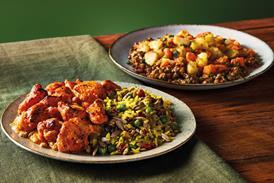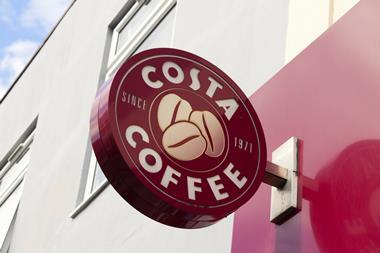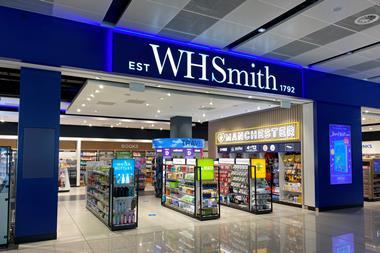With £48m of debt, loss-making Typhoo looks to be in hot water but CEO Keith Packer says he can make the business break even in 18 months, writes Chloe Smith
When Keith Packer thumbed through his memos on the first day in his new job, he likely needed a strong cuppa. The former sales director and now new chief executive of Typhoo has by any standards a gargantuan challenge on his hands. His task is to turn around a loss-making company saddled with huge debts. First on Packer’s agenda is to extract Typhoo from the financial crisis that has it owing almost £50m.
The mess Typhoo finds itself in dates back to October 2005 when Indian conglomerate Apeejay Surrendra bought Typhoo for £80m from Premier Foods. Back then debt was cheap and a £48m loan was made to Typhoo through a subsidiary of Apeejay Surrendra, which was scheduled to be paid back in annual chunks by 2012.
Despite Typhoo posting a loss of £992,950 in the first set of annual accounts filed after it was sold (to 31 March 2006), the directors said they would become profitable by growing Typhoo’s share of the branded tea market and increasing manufacturing efficiency. But the following year, to March 2007, losses had risen to more than £6m. By the year to March 2008, the figure had reached £10.3m and the company had breached a debt covenant by failing to meet its loan repayment on time. This triggered an accounting penalty whereby the full balance on the £48m loan was payable within the year. Packer says the company paid back a separate £6.3m bank loan that was also due by the end of the financial year two weeks ago, but the £48m loan is still owed.
Typhoo has the full backing of its parent company, stresses Packer. “We have a long-term commitment from both Apeejay Surrendra and our majority shareholders to continue to fund the business.” And Packer says it will cut costs to break even within 12 to 18 months, specifically by bringing storage of tea in-house, as well as obtaining new business.
But wider market conditions do not give grounds for optimism. The commodity spike last year inflated tea prices and the weak pound means tea, which is traded in dollars, is now 25% costlier on currency difference alone than 12 months ago. Tea consumption, meanwhile, is stagnant. The hot beverages category increased by just 0.3% in value last year and own label, which accounts for more than half of Typhoo’s business, was down 8.8% [The Grocer’s Top Products Survey, Nielsen, MAT 4 October 2008].
Sales of the Typhoo brand itself slipped 0.7% to £21.1m in that period. When you consider that Yorkshire Tea increased sales by 2.7% to £32.6m, Typhoo’s designs on reclaiming its status as Britain’s third-favourite tea brand look tough. To make matters worse, the company’s sales in the big four have fallen, according to TNS data seen by The Grocer. Volume sales of Typhoo’s branded tea in 2008 fell 13% year-on-year at Sainsbury's, 10% at Asda and 44% at Morrisons. Branded volumes at Tesco were up 6.7% – equivalent to 150 tonnes – but own-label volume fell by 700 tonnes. And although the share of Typhoo’s sales at discounters now account for a far higher percentage of sales (up from 14% to 38% in the past three months), they typically provide far lower margins.
“They’ve tried to resurrect Typhoo as the third brand behind P&G, Tetley and own label,” says one tea industry executive. “But when you think of the rise of Yorkshire Tea and Twinings Everyday you’ve got five branded players alongside own label. Something has got to give. Their gross margins are 9.5% when most brands are about 60%.”
Packer remains positive. “We have a new proposition for the brand that we will be taking to our customers shortly,” he says, adding the challenge now is to revamp Typhoo to appeal to its target market of 45 to 60-year-old women. “Typhoo is an important brand,” insists Packer. That may be true, but he has his work cut out to keep it that way.
When Keith Packer thumbed through his memos on the first day in his new job, he likely needed a strong cuppa. The former sales director and now new chief executive of Typhoo has by any standards a gargantuan challenge on his hands. His task is to turn around a loss-making company saddled with huge debts. First on Packer’s agenda is to extract Typhoo from the financial crisis that has it owing almost £50m.
The mess Typhoo finds itself in dates back to October 2005 when Indian conglomerate Apeejay Surrendra bought Typhoo for £80m from Premier Foods. Back then debt was cheap and a £48m loan was made to Typhoo through a subsidiary of Apeejay Surrendra, which was scheduled to be paid back in annual chunks by 2012.
Despite Typhoo posting a loss of £992,950 in the first set of annual accounts filed after it was sold (to 31 March 2006), the directors said they would become profitable by growing Typhoo’s share of the branded tea market and increasing manufacturing efficiency. But the following year, to March 2007, losses had risen to more than £6m. By the year to March 2008, the figure had reached £10.3m and the company had breached a debt covenant by failing to meet its loan repayment on time. This triggered an accounting penalty whereby the full balance on the £48m loan was payable within the year. Packer says the company paid back a separate £6.3m bank loan that was also due by the end of the financial year two weeks ago, but the £48m loan is still owed.
Typhoo has the full backing of its parent company, stresses Packer. “We have a long-term commitment from both Apeejay Surrendra and our majority shareholders to continue to fund the business.” And Packer says it will cut costs to break even within 12 to 18 months, specifically by bringing storage of tea in-house, as well as obtaining new business.
But wider market conditions do not give grounds for optimism. The commodity spike last year inflated tea prices and the weak pound means tea, which is traded in dollars, is now 25% costlier on currency difference alone than 12 months ago. Tea consumption, meanwhile, is stagnant. The hot beverages category increased by just 0.3% in value last year and own label, which accounts for more than half of Typhoo’s business, was down 8.8% [The Grocer’s Top Products Survey, Nielsen, MAT 4 October 2008].
Sales of the Typhoo brand itself slipped 0.7% to £21.1m in that period. When you consider that Yorkshire Tea increased sales by 2.7% to £32.6m, Typhoo’s designs on reclaiming its status as Britain’s third-favourite tea brand look tough. To make matters worse, the company’s sales in the big four have fallen, according to TNS data seen by The Grocer. Volume sales of Typhoo’s branded tea in 2008 fell 13% year-on-year at Sainsbury's, 10% at Asda and 44% at Morrisons. Branded volumes at Tesco were up 6.7% – equivalent to 150 tonnes – but own-label volume fell by 700 tonnes. And although the share of Typhoo’s sales at discounters now account for a far higher percentage of sales (up from 14% to 38% in the past three months), they typically provide far lower margins.
“They’ve tried to resurrect Typhoo as the third brand behind P&G, Tetley and own label,” says one tea industry executive. “But when you think of the rise of Yorkshire Tea and Twinings Everyday you’ve got five branded players alongside own label. Something has got to give. Their gross margins are 9.5% when most brands are about 60%.”
Packer remains positive. “We have a new proposition for the brand that we will be taking to our customers shortly,” he says, adding the challenge now is to revamp Typhoo to appeal to its target market of 45 to 60-year-old women. “Typhoo is an important brand,” insists Packer. That may be true, but he has his work cut out to keep it that way.















1 Readers' comment